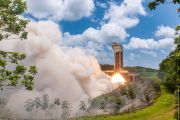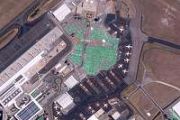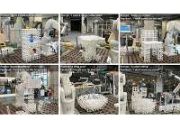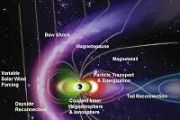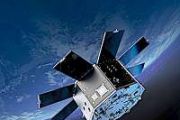
Copernical Team
Tonga underwater volcano disrupted satellite signals halfway around the world
 An international team has used satellite- and ground-based ionospheric observations to demonstrate that an air pressure wave triggered by volcanic eruptions could produce an equatorial plasma bubble (EPB) in the ionosphere, severely disrupting satellite-based communications. Their findings were published in the journal Scientific Reports.
The ionosphere is the region of the Earth's upper a
An international team has used satellite- and ground-based ionospheric observations to demonstrate that an air pressure wave triggered by volcanic eruptions could produce an equatorial plasma bubble (EPB) in the ionosphere, severely disrupting satellite-based communications. Their findings were published in the journal Scientific Reports.
The ionosphere is the region of the Earth's upper a SmartSat targets Australian agricultural intelligence from space
 SmartSat Cooperative Research Centre (CRC), Australia's leading space research centre, has launched a new research program, 'Maya Nula', to develop Australian satellite Earth Observation (EO) capability with space sensor technology to advance Australia's agriculture industry.
The name Maya Nula, which translates to "eyes here, there, everywhere" in the Dharug language of the Eora nation, a
SmartSat Cooperative Research Centre (CRC), Australia's leading space research centre, has launched a new research program, 'Maya Nula', to develop Australian satellite Earth Observation (EO) capability with space sensor technology to advance Australia's agriculture industry.
The name Maya Nula, which translates to "eyes here, there, everywhere" in the Dharug language of the Eora nation, a Iridium adds to constellation resilience with launch of spare satellites
 Iridium Communications Inc. (NASDAQ: IRDM) has announced a key milestone in its long-term constellation resilience and redundancy planning, with the successful launch and deployment of five spare satellites. This launch brings the total number of spare Iridium satellites on orbit to 14. In total, 81 next-generation Iridium satellites were built, and 80 of them have now been deployed. The Iridium
Iridium Communications Inc. (NASDAQ: IRDM) has announced a key milestone in its long-term constellation resilience and redundancy planning, with the successful launch and deployment of five spare satellites. This launch brings the total number of spare Iridium satellites on orbit to 14. In total, 81 next-generation Iridium satellites were built, and 80 of them have now been deployed. The Iridium Has Gaia found missing link in black hole evolution
 When ESA's Gaia spacecraft scanned the Scorpius constellation and its ancient globular star cluster Messier 4, it captured something strange: a huge dark blob at the cluster's centre, 800 times more massive than our Sun.
It is normal for globular clusters to have dark centres made up of many dead stars. But the mass at the centre of Messier 4 looks different - despite being especially larg
When ESA's Gaia spacecraft scanned the Scorpius constellation and its ancient globular star cluster Messier 4, it captured something strange: a huge dark blob at the cluster's centre, 800 times more massive than our Sun.
It is normal for globular clusters to have dark centres made up of many dead stars. But the mass at the centre of Messier 4 looks different - despite being especially larg Research 'solves' mystery of Jupiter's stunning colour changes
 Academics at the University of Leeds believe they could have found the answer to a long-running mystery behind Jupiter's famous "stripes".
Pictures of the planet are characterised by bands of colour, as well as the famous Great Red Spot, but these bands are often seen to move and change - something which scientists have until now not been able to explain.
Now thanks to a new discover
Academics at the University of Leeds believe they could have found the answer to a long-running mystery behind Jupiter's famous "stripes".
Pictures of the planet are characterised by bands of colour, as well as the famous Great Red Spot, but these bands are often seen to move and change - something which scientists have until now not been able to explain.
Now thanks to a new discover First observation of a Polar Cyclone on Uranus
 For the first time, NASA scientists have strong evidence of a polar cyclone on Uranus. By examining radio waves emitted from the ice giant, they detected the phenomenon at the planet's north pole. The findings confirm a broad truth about all planets with substantial atmospheres in our solar system: Whether the planets are composed mainly of rock or gas, their atmospheres show signs of a swirling
For the first time, NASA scientists have strong evidence of a polar cyclone on Uranus. By examining radio waves emitted from the ice giant, they detected the phenomenon at the planet's north pole. The findings confirm a broad truth about all planets with substantial atmospheres in our solar system: Whether the planets are composed mainly of rock or gas, their atmospheres show signs of a swirling OSIRIS-REx Recovery Team Motto: 'Practice, Practice, Practice'
 In anticipation of NASA's OSIRIS-REx asteroid sample delivery this fall, the team held our first round of rehearsals April 17 to April 27. Our goal was to practice retrieving the spacecraft's sample capsule from a simulated landing site at Lockheed Martin's campus near Denver.
I am the Lockheed Martin-based ground recovery lead for sample recovery operations and will help guide the team th
In anticipation of NASA's OSIRIS-REx asteroid sample delivery this fall, the team held our first round of rehearsals April 17 to April 27. Our goal was to practice retrieving the spacecraft's sample capsule from a simulated landing site at Lockheed Martin's campus near Denver.
I am the Lockheed Martin-based ground recovery lead for sample recovery operations and will help guide the team th Global team simulates message from extraterrestrial intelligence to Earth
 What would happen if we received a message from an extraterrestrial civilization? Daniela de Paulis, an established interdisciplinary artist and licensed radio operator who currently serves as Artist in Residence at the SETI Institute and the Green Bank Observatory, has brought together a team of international experts, including SETI researchers, space scientists, and artists, to stage her lates
What would happen if we received a message from an extraterrestrial civilization? Daniela de Paulis, an established interdisciplinary artist and licensed radio operator who currently serves as Artist in Residence at the SETI Institute and the Green Bank Observatory, has brought together a team of international experts, including SETI researchers, space scientists, and artists, to stage her lates Rocket Lab scoops up Virgin Orbit Long Beach California assets
 Rocket Lab USA, Inc. has been selected as a successful bidder and is finalizing an asset purchase agreement for the purchase of certain Long Beach California aerospace production and manufacturing assets from Virgin Orbit Holdings, Inc. and certain of its subsidiaries ("Virgin Orbit") in Virgin Orbit's Chapter 11 bankruptcy auction.
Rocket Lab's successful bid of approximately $16.1 millio
Rocket Lab USA, Inc. has been selected as a successful bidder and is finalizing an asset purchase agreement for the purchase of certain Long Beach California aerospace production and manufacturing assets from Virgin Orbit Holdings, Inc. and certain of its subsidiaries ("Virgin Orbit") in Virgin Orbit's Chapter 11 bankruptcy auction.
Rocket Lab's successful bid of approximately $16.1 millio Shenzhou XVI mission to launch in days
 China's next manned mission, the Shenzhou XVI, is scheduled to be launched in the coming days to transport three astronauts to the Tiangong space station, according to the China Manned Space Agency.
The Shenzhou XVI crewed spacecraft and its carrier, a Long March 2F rocket, were moved to the service tower on Monday at the Jiuquan Satellite Launch Center in northwestern China's Gobi Desert,
China's next manned mission, the Shenzhou XVI, is scheduled to be launched in the coming days to transport three astronauts to the Tiangong space station, according to the China Manned Space Agency.
The Shenzhou XVI crewed spacecraft and its carrier, a Long March 2F rocket, were moved to the service tower on Monday at the Jiuquan Satellite Launch Center in northwestern China's Gobi Desert, 











